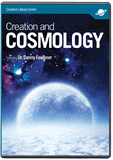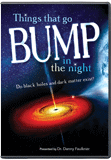
Cosmos Review: “Sisters of the Sun”
Episode Eight of Cosmos: A SpaceTime Odyssey
Cosmos Articles and Discussion Guides
See Cosmos: A SpaceTime Odyssey for reviews of other episodes and discussion guides for further study.
“Sisters of the Sun,” episode eight of Cosmos: A SpaceTime Odyssey, mingles fascinating physics and astronomy with evolutionary interpretations that cannot be tested or observed. Host Neil deGrasse Tyson ultimately draws conclusions connecting “stellar evolution” to molecules-to-man evolution, continuing beyond the realm of observable science into the speculative realm.
Snapshots
As when biological evolutionists string together a series of discrete fossils and claim that connecting the dots demonstrates an ancestral relationship, so evolutionary astronomers string together a series of stellar “snapshots” to fit their story of origins. By studying these snapshots astronomers can learn a lot about stars and even speculate reasonably well about how they should change as they use up their fuel supplies. The danger lies in extrapolating from stellar physics to presumptive evolutionary conclusions.
Oops!
Much of the information presented in “Sisters of the Sun”—except of course for the vast timescales that emerge from evolutionary presumptions—represents reasonable conclusions based on observable astronomy and physics. Answers in Genesis astronomer Dr. Danny Faulkner notes, however, that Tyson and his scriptwriters erred when discussing the bright star Sirius and its companion. Dr. Faulkner observes,
In talking about novae, it’s been our understanding for some time now that novae occur in “close binary stars.” In these close binary stars, one star is a white dwarf. These stars are close enough to one another in the binary system that matter from the non-white dwarf star transfers onto the white dwarf, and it builds up this fuel and ignites through nuclear fusion. It flares up and makes the star brighter. But this can only happen in a close binary star where one of the stars is a white dwarf, and typically the orbital period can be at most a few days. Otherwise the stars are too far apart for fuel to be transferred.
Sirius is the brightest star in the sky and has a white dwarf companion, but that companion orbits much too far from Sirius, with an orbital period of around 50 years. Thus I was quite surprised when Tyson mentioned that one day as Sirius A swells and material slops over to Sirius B the Sirius system might flare into a nova. These stars are not nearly close enough to do that.
Dr. Faulkner adds that Tyson, as an astrophysicist, should have caught that factual error in his script.

Many facts can be learned about stars through careful observation. For instance, most stars are, like our sun, “main sequence stars,” shining because they fuse hydrogen to helium in their cores. And unlike our sun, many stars are binary stars. Sirius, pictured here, is the brightest star in our sky. Sirius has a small companion star, a white dwarf (small dot on lower left). They revolve around each other about every 50 years. Image: NASA, H.E. Bond and E. Nelan (Space Telescope Science Institute, Baltimore, Md.); M. Barstow and M. Burleigh (University of Leicester, U.K.); and J.B. Holberg (University of Arizona) through Space.com
See Stars
The program dealt only briefly with the original origin of stars, a most problematic issue for evolutionary astronomers. Dr. Faulkner, noting that evolutionary astronomers are no closer today to explaining the origins of the stars in the universe than in the 1960s, comments, “Gas clouds don’t spontaneously contract. That’s their big unsolved mystery that you’ve got to get around at the beginning.”
Once we begin to consider galaxies full of stars from our earthly vantage point, we are at least making observations in the present. (We’ve previously discussed some issues associated with considering our look into space as an adventure back in time in the review of episode four, “Cosmos Review: ‘A Sky Full of Ghosts’.”) Much of what was presented in the Cosmos episode this week relates to observable astronomy and physics. For instance, painstaking observations, catalogued by women at Harvard in the early 20th century, enabled astronomers to group the stars into spectral types. Stellar observations reveal red giants, white dwarfs, blue stars, neutron stars, and many others. Study of their spectra has enabled astrophysicists to know what elements are in the stars and to relate the color and size of individual stars to their temperature, mass, and other characteristics. But knowledge of their characteristics reveals neither their age nor how they came to exist.
Stellar Evolution
We know from the Bible that God created the stars on Day Four of Creation Week about 6,000 years ago. Yet it only makes sense in light of physics that, as Dr. Faulkner explains, “Stars consume their fuel—we think through nuclear fusion—in order to shine, and as a star ages it should use up its fuel. Using physics we can model what would be expected to happen when its fuel is exhausted.”
It makes sense from physics that stars change over time. But can we know how long these processes will take? Or how long they took in the past? The problem is, we cannot know what happened in the unobservable past nor can we necessarily anticipate continuing long enough to see if the predicted ten billion year lifespan of our sun will pan out. As with radiometric dating, millions- and billions-year assumptions about the past are based on assumptions that all the conditions and circumstances represented in models perfectly represent reality and that the rates predicted for processes have never varied.
Young Universe
Since none of us are likely to hang around on Earth long enough to see if the predicted transformations occur in the time and sequence predicted, and certainly no scientist was around to document the timescale of stellar evolution in the past, is there any way we can demonstrate that the predicted “millions-and-billions” are problematic? (After all, for radiometric dating, as we discussed last week, we can demonstrate the fallacy of assuming that the “nuclear clock ticks at a rate that has never varied” by producing rocks from the Grand Canyon that have been dated to different ages by different methods, with variations systematically occurring in a way that is consistent with the biggest documented wrinkle in Earth’s history, the global Flood.) Is there comparable observable evidence to show that there are problems with these unobserved billions?
Blue stars must burn out in “just” a million years but these stars are abundant and appear in every galaxy we’ve observed.
The existence of blue stars is a major problem for the timescale projected in stellar evolution. Cosmos host Neil deGrasse Tyson called our attention to the constellation Orion, but he failed to share this problem. The three stars in Orion’s belt are blue stars. While our sun theoretically has enough fuel to endure for 10 billion years, the much more massive, hotter burning, brighter blue stars like those that glitter in Orion’s belt are using up their fuel quickly. Based on the same method of calculation that gives a 10-billion-year potential lifespan for our sun, blue stars must burn out in “just” a million years. Blue stars are abundant and appear in every galaxy we’ve observed.
Similar calculations can be made for each kind of star. Based on those numbers, only red dwarfs have enough fuel to have been burning since the time of the supposed big bang. The universe, according to the Bible, is only about 6,000 years old; therefore, a million-year expiration deadline for the blue stars and short-timescales for most other stars are not problems for a biblical model of creation. These are, however, problems for the conventionally accepted models.
Stellar Nurseries
While some astronomers speculate that certain formations are stellar nurseries resupplying the universe with stars, these too are just snapshots. For instance, when a very bluish galaxy, apparently dominated by blue stars, was discovered in 2012, Dr. Faulkner responded to the claim this was a stellar nursery saying, “When a galaxy such as this appears very blue, it likely is because the galaxy's light is dominated by these bright, hot stars with very short lifetimes. However, the conclusion that there is a great deal of star birth happening there is an inference that is laden with evolutionary assumptions.”
Whether or not stars are still forming today, the Bible does not specify, but no one has ever seen a star form. Furthermore, the physics of getting a hot gas cloud to compress in defiance of gas pressure, magnetic field strength, and angular momentum driving it to do otherwise are also problematic.1 In Are Stars Still Forming Today? Dr. Faulkner points out that even if God has put mechanisms in place to produce new stars, the physics demands that stars already exist to drive the production of such replacements. So if the universe is full of blue stars burning out rapidly, why do we not observe—actually observe—lots of new stars being born?
Conventional evolutionary models cannot adequately explain the existence of so many blue stars nor frankly the existence of stars in the first place. The physics of what happens in stars of different types—the equilibrium between expanding gas and gravitational compression, the conservation of energy, and the nuclear fusion—are all things we can observe. But extrapolating to the untestable and unobservable astronomical timescales in violation of biblical history—in defiance of the blue-star-testimony that is consistent with a young universe, and without any naturalistic way to actually explain the existence of a star-filled universe in the first place—is a problem.
Exalting Creation Instead of Creator
The timescale unapologetically presented for the changes expected as stars age is not the only problem with “Sisters of the Sun.” Drawing the episode to a close by celebrating our supposed oneness with stardust, Tyson says,
Our ancestors worshipped the sun. They were far from foolish. It makes good sense to revere the sun and stars because we are their children. The silicon in the rocks, the oxygen in the air, the carbon in our DNA, the iron in our skyscrapers, the silver in our jewelry—were all made in stars billions of years ago. Our planet, our society, and we ourselves are stardust.
After reviewing how the sun’s energy is captured by plants, Tyson exclaims, “Sunshine into moonshine!” and as he drinks a glass of wine he adds,
I can feel my brain turning the chemical energy in the wine into the electrical energy of my thoughts and directing my vocal cords to produce the acoustic energy of my voice. Such transformations of energy are happening everywhere, all the time. Energy from our star drives the wind and the waves and life around us. How lucky we are to have this vast source of clean energy falling like manna from heaven for all of us!
Tyson concludes,
It is beginning to be clear on our world that we are made by the atoms and the stars, that our matter and our form are forged by the great ancient cosmos of which we are a part.
Stellar Nuclear Synthesis
Tyson credits ancient stars with synthesizing all the elements needed for life to evolve. “Chemical enrichment”—the idea that all elements were created through fusion in stars that subsequently exploded and scattered their stardust throughout the universe—has been popular for decades. It arose when big bang cosmologists realized the big bang model could not be coaxed to produce any elements but hydrogen, helium, and a little lithium. Spectroscopy reveals that other elements exist in stars, so stardust was recruited to supply the stuff of life and of everything else. But this notion is purely an evolutionary assumption. The existence of elements in stars does not demonstrate that exploding stars seeded the universe with the elements, much less that stardust supplied the elements from which life evolved—another insupportable claim. (Read more about the evolutionary failure to trace life back to its chemical origins in our recent report of evolutionists’ startling admissions of failure.)
Bright Stars and Dark Hearts
An inspirational conclusion—analogous to the “soaring spiritual experience” Tyson described as he pondered his “kinship with all life on Earth”—this ode at the end of Cosmos “Sisters of the Sun” illustrates something God, speaking through the Apostle Paul, describes in the book of Romans:
For the wrath of God is revealed from heaven against all ungodliness and unrighteousness of men, who suppress the truth in unrighteousness, because what may be known of God is manifest in them, for God has shown it to them.
For since the creation of the world His invisible attributes are clearly seen, being understood by the things that are made, even His eternal power and Godhead, so that they are without excuse, because, although they knew God, they did not glorify Him as God, nor were thankful, but became futile in their thoughts, and their foolish hearts were darkened.
Professing to be wise, they became fools. (Romans 1:18–22)
“How Lucky We Are” or How Blessed?
The Bible tells us that the sun, moon, and stars were set up by God as markers for times and seasons (Genesis 1:14–16), and they are testaments to the greatness of the Creator who made them. “The heavens declare the glory of God; And the firmament shows His handiwork
” (Psalm 19:1). Science reveals many marvelous facts about the stars. Of stellar astronomy, Dr. Faulkner says, “I find the physics compelling.” How tragic that the worldview paraded in this episode, instead of glorifying the God who created all things, makes a point of comparing the sun’s energy to lucky manna from heaven and then declares the atoms and stars created us. God, in the very book of the Bible where the giving of manna from heaven is recorded, reiterates the truth of Creation Week:
“For in six days the Lord made the heavens and the earth, the sea, and all that is in them, and rested the seventh day
” (Exodus 20:11).
As we draw to the close this review then let us put the praise where it belongs, on the “true bread from heaven
” (John 6:32–33) who gives us life, God’s greatest gift to us, Jesus Christ, by whom “all things were created
” (Colossians 1:16) and through whom we have received all good gifts (James 1:16–17) for life (John 3:16–18; 14:6) in this world and the next.
For more information:
Footnotes
- Star formation supposedly happens when swirling gas cools and condenses until it is dense enough to possess enough gravity to prevent re-expansion. However, gases tend to expand, not contract. Furthermore, if a swirling mass of gas contracted, it would spin faster in order to conserve angular momentum, and that increased angular velocity would oppose ongoing contraction. Finally, the great increase in the magnetic field that would accompany the massive collapse of gas would oppose the shrinkage needed to form a star. Ongoing star birth therefore seems unlikely. Astronomical wonders, such as the Herbig-Haro object reported last year and the bluish galaxy cluster discovered by the Chandra X-ray telescope in 2012 currently thought to be stars forming likely have other explanations.
- Cosmos is promoted as educational material to teachers of teenagers. Our society is rife with illegal teenage alcohol consumption and rampant drunk driving, alcoholism, and alcohol-related illnesses among people from all walks of life. It is therefore inappropriate for the astrophysicist-host of Cosmos, who should be a role model in this presumably educational program, to exult over the consumption of alcohol, alluding poetically to its effect in a series promoted for use with students.
Recommended Resources

Answers in Genesis is an apologetics ministry, dedicated to helping Christians defend their faith and proclaim the good news of Jesus Christ.
- Customer Service 800.778.3390
- © 2024 Answers in Genesis







